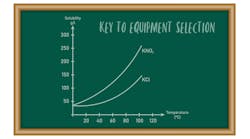Powder Handling: Deftly Deal With Wet Cakes And Pastes
Issues posed by wet solids dampen the performance of many processes. In a previous column, “Improve Slurry Handling,” I explored several techniques for altering the bulk properties of wet cakes, pastes and slurries. However, it’s not always possible to change these properties because doing so may reduce the product’s functionality. It’s better to select the correct equipment for the product in the first place and ensure the operators understand the differences in handling slurries, wet cakes and pastes compared to bulk solids and powders. The major areas requiring additional consideration and care are storage, discharge and conveying.
[pullquote]
First, it’s never a good idea to store slurries, wet cakes and pastes for any length of time; so, I always suggest designing a process to avoid this situation.
Slurries commonly are stored for short periods of time. I provided advice on dealing with slurry storage and conveying in an article way back in 2006, “Avoid Trouble with Slurries”; those tips remain just as valid today.
Sometimes, storing wet cakes and pastes is necessary. Their handling is a specialized area; most manufacturers don’t produce all the equipment variations that you may need. As a consequence, the designer must explore many different vendors’ capabilities before making a selection.
You just can’t pour a wet cake or paste into a tank or silo and expect to retrieve it without great difficulty. For large storage volumes, silos often include screws placed near the bottom or top with either side or center discharge. Another variation is to rotate the silo base while the bottom screw is stationary. Some designs incorporate a reciprocating floor or frame to guide solids toward the discharge screw. These devices can help ensure maintaining first-in/first-out performance. Ease of maintenance of the motors and drives becomes the driving factor in selection.
Hoppers offer short-term storage; liners or vibration can improve the product’s flowability. To properly choose a liner, you must conduct flowability tests. In addition, installation can pose several pitfalls. These include the wrong type of attachment (i.e., bolt, screw or glue) that can lead to corrosion or mechanical failure, and not having enough attachments. You also must properly cap and install valleys to allow for thermal expansion; often this requires overlapping the liner sheets.
Pneumatic techniques for assisting hopper discharge aren’t well-suited to wet solids where injected air can channel between lumps. Arches will form; these likely will be strong. Even inflatable pads located around the hopper aren’t recommended, especially for very wet solids, because they can compact the material.
Wet solids are poor transmitters of vibration, so vibrational aids usually aren’t very effective. However, a vibration technique may make sense for either fairly dry or nearly saturated wet solids that aren’t too sticky. Vibrating a nearly saturated cake may allow a lubricating film of solvent to form at the wall, thus increasing slippage. Devices that vibrate the material rather than the hopper generally work better because they impart a more-uniform vibration; these include louvers or moveable cones at the discharge. When vibration of the material isn’t possible, externally mounted vibrators that produce a vertical stress like an out-of-balance motor or air-driven ball or roller are most effective while horizontal vibration from, e.g., an air piston or electromagnetic force, is less effective.
Belt conveyors most commonly transport wet solids and pastes. Wet solids require more attention to belt speed, cleaning and operator protection. Belts often serve not only to move the material but also to lift it. However, for wet cakes of variable solvent content, this may cause balling of the solids.
Screw and ribbon conveyors frequently move wet cakes and pastes; they are less desirable, though, due to friction that can lead to pluggage or failure of the equipment. Ribbons, especially ones with an interrupted flight design, work well on sticky materials compared to a solid screw, but at the expense of efficiency. A low bed depth is best for a wet cake because it increases the transport velocity and reduces adhesion to the trough. There is no free lunch.



